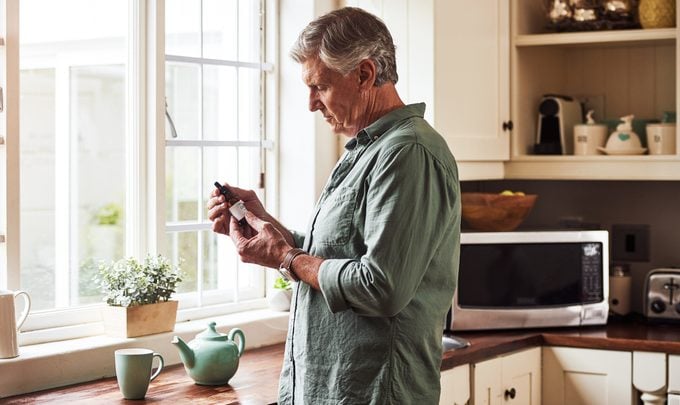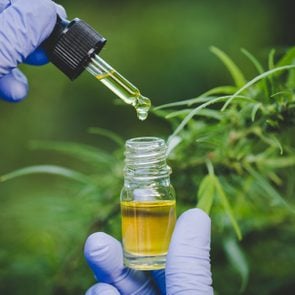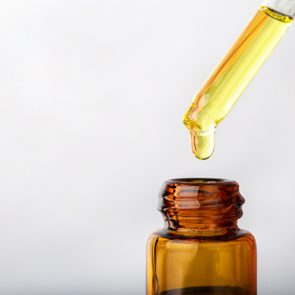What You Need to Know About Using CBD Oil for Pain
Updated: Apr. 01, 2021
While many swear by CBD for pain relief, the evidence for its analgesic powers in humans is still scarce. If you are thinking about trying it, here are the potential risks and benefits, possible doses, and tips on how to use CBD oil for pain.
Our editors and experts handpick every product we feature. We may earn a commission from your purchases.
How to use CBD oil for pain
If you have chronic pain symptoms, you’ve likely been fighting dull or throbbing achiness for months. Maybe you know the cause, or maybe it’s a mystery. You’ve likely tried several ways to manage your pain.
In an online survey of more than 2,400 people who use CBD, chronic pain was the No. 1 reason they used CBD products. The second most common reason they used CBD was to help ease joint pain/arthritis. (Here’s what you should know about using CBD for arthritis.)
Some people report that taking CBD oil, CBD tincture, or other oral CBD formulations, or applying topical treatments like CBD cream or CBD spray to a painful area, helps them manage pain that hasn’t responded well to other therapies.
“There are some lines of evidence to suggest that this treatment might be helpful for people in pain,” says Roger S. McIntyre, MD, a professor of psychiatry and pharmacology at the University of Toronto. “But the scientific evidence doesn’t seem to be as robust and compelling at this stage as the enthusiasm for it in the population seems to be.”
There’s great evidence to show that CBD can ease inflammation, for example, and acts on multiple targets that could affect pain perception. But nearly all of this research comes from studies done in laboratory dishes and mice, Dr. McIntyre and other experts say.
The best evidence on the benefits and risks of CBD comes from studies of Epidiolex, a synthetic formulation of CBD in sesame oil. It went through the standard drug approval process at the U.S. Food and Drug Administration (FDA), notes Kevin Boehnke, PhD, a research investigator at the Chronic Pain & Fatigue Center at Michigan Medicine in Ann Arbor. He studies the use of cannabinoids for pain. (The FDA approved Epidiolex in 2018 for treating two types of rare seizure in children.)
“What’s happening at this point is a lot of people are just figuring it out for themselves,” Boehnke says. “People are kind of going it alone, and hopefully communicating with their health care provider.”
How it might work
Our bodies make chemical messengers called endocannabinoids that interact with receptors on cells throughout the body, including areas of the brain and spinal cord involved in sensing pain.
These endocannabinoids and the receptors they connect with—as well as the enzymes responsible for building and breaking down endocannabinoids—form the endocannabinoid system (ECS). The ECS helps maintain balance in every organ system in the body, modulating mood, sleep, appetite and digestion, and pain perception.
CBD interacts with endocannabinoid receptors too. That’s why investigators are trying to figure out if it might help people manage their pain by boosting ECS function, for example.

What’s the evidence?
CBD has been studied for treating pain since the early 2000s. Small studies found it helped some patients with chronic pain or difficult-to-treat pain from nerve damage (also called neuropathic pain, and if it’s diabetes related, diabetic neuropathy).
“Based on observational studies and basic science studies, there’s an indication that cannabidiol or CBD may have anti-inflammatory properties, it might have analgesic properties, and it might help with disturbed sleep,” says Jason Busse, PhD, an associate professor at McMaster University in Hamilton, Ontario who studies chronic pain. “If that was true, then you can see all of those mechanisms of action helping individuals with chronic pain.”
A 2020 audit of 400 patients with non-chronic cancer pain in New Zealand, where CBD is legal by prescription, found they reported less pain, better sleep, and improved quality of life while using CBD, with few adverse events. The findings were published in BJGP Open.
A case report in a 2020 issue of the Journal of Opioid Management discussed two patients with severe back pain, one due to a vertebral fracture and the other due to cancer and the aftermath of surgery to treat it. Both patients found “symptom and pain relief” with CBD cream, according to the report.
There’s also evidence that CBD can help reduce opioid use. In a study of 131 patients who were on opioids for a year or more to treat chronic pain, just over half of those who took a CBD-rich hemp extract for eight weeks reduced or eliminated their opioid use.
Most of the clinical trials of CBD for pain have tested it in combination with delta-9-tetrahydrocannabinol (THC), Busse notes. (CBD and THC are both compounds that come from the cannabis plant. But THC is the main mind-altering chemical that makes people feel high. CBD doesn’t make you high.)
When CBD and THC are taken together, some studies show about a 10 percent benefit—meaning you have a 10 percent chance of being helped, Busse says. But it’s unclear whether CBD alone is beneficial or if THC has to be in the mix. (Here’s more on the differences between CBD vs THC.)
In other words, “from what we know, the majority of patients will not see a benefit, a minority will,” Busse says. “There does appear to be an effect, but the effect is pretty modest.”
By comparison, he adds, the effect of opioids for treating pain are not much higher (12 percent). Here are some of the best CBD creams for pain that come expert-recommended.
Side effects of CBD
At very high doses of CBD used in clinical trials of Epidiolex, some patients developed abnormal liver function tests. Other reported side effects included nausea, diarrhea, fatigue, irritability, and sleep problems.
CBD may also interact with warfarin (Coumadin), a popular blood thinner. They break down in the same way, so CBD can increase the levels of Coumadin in your body.
If you take any medicines that can’t be taken with grapefruit juice, then you may want to reconsider taking CBD. It can raise levels of those drugs in your body in the same way that grapefruit juice can. (Grapefruit juice interacts with some medications, making them more potent.) It’s always a good idea to check with your doctor.
What dose?
People using CBD for pain may take it by mouth for overall effects, or apply it topically to a spot that aches. Oral formulations include CBD edibles and CBD capsules, which require at least a half-hour to take effect, and often longer. Formulations that can be taken under the tongue, such as CBD oil and CBD tinctures, reach the bloodstream more quickly.
Inhaling CBD in the form of CBD vape oil is the fastest-acting approach. But that carries its own health risks.
Figuring out the best CBD dose for pain basically involves “starting low and going slow,” and should be personalized, according to Project CBD, a California nonprofit that supports research on CBD.
You have several options for CBD products:
- Full spectrum, meaning it contains all of the other components of the hemp plant, including small amounts of THC and plant compounds known as terpenes
- Broad spectrum, which contains all of these components plus CBD, but no THC
- CBD isolates, which contain CBD only
Full-spectrum and broad-spectrum CBD products may be effective at lower doses than CBD isolates because they contain other plant components that can have synergistic effects.
The Arthritis Foundation recommends starting with a few milligrams of CBD twice daily, taken sublingually, and staying at that dose for one week. If you don’t feel any effect, double the original dose and then go up in small increments each week.
Make a treatment plan
If you’re interested in trying CBD for pain, work with your health care provider to come up with a treatment plan that covers what treatment success would look like for you, Boehnke says. Be sure to track symptoms and negative effects so you can weigh the risks and benefits of CBD.
Tracking symptoms will help you figure out if you’re actually seeing a benefit, and avoid wasting money on a therapy that isn’t helping.
High-quality CBD products are expensive, and it can take some research to find them, notes Bonni Goldstein, MD, medical director and owner of Cannacenters, a medical practice in Los Angeles, and author of Cannabis is Medicine: How Medical Cannabis and CBD are Healing Everything from Anxiety to Chronic Pain.
Dr. Goldstein and other experts recommend purchasing CBD through a licensed dispensary if marijuana is legal in your state. If this isn’t an option, track down products with a batch-specific Certificate of Analysis that, ideally, confirms the CBD content stated on the label and that the product is free from contamination with heavy metals, pesticides, or mold. Here are some of the best CBD oils for pain that meet our experts’ quality and safety criteria.
Your CBD treatment plan should also address other drugs and supplements you’re taking and include lifestyle habits that can make it easier to cope with pain, such as regular exercise, a healthy diet, and adequate sleep, Boehnke adds.




















